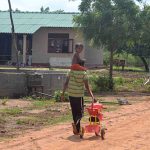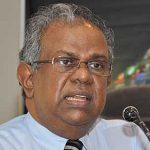Best Practice:
The Sri Lanka Village That’s A Model For Hope + Reconciliation
The way that members of different religious and racial groups live together in Viharahena village is a model for future Sri Lankan reconciliation.
It is hard to say whether the building is a Hindu temple or a Buddhist one. All the visitors bring flowers, incense and lamps and many of the locals participate in the same holiday parades, whether they are the Buddhist Wesak parade or the Hindu Vel parade. And the same locals that organize the Buddhist Kathina ceremony produce Hindu celebrations, and even Christmas.
The location of this multi-sectarian building is in Viharahena, a small town in Sri Lanka’s south, next to another neighbourhood called Ensalwatta.
“Even in my grandfather’s time it was like that,” says K. Velayutham, a local man who cleans the temple and performs rituals there. “There are Sinhalese and Tamil people on the nearby tea estate. This place is open to Hindus, Catholics, Buddhists and Muslims. Nobody’s feelings are hurt here.”
We don’t see any difference between the Sinhalese and the Tamils. It’s been this way here for generations.
The temple is open to Buddhists and Hindus, confirms the village’s head monk, Mederipitiye Dhammasiri.
“Among the Buddhist children, it is a Tamil child who always gets the best marks in the Sunday school,” Dhammasiri says. “The Kathina and Wesak stories are done together by both Sinhalese and Tamil locals. And the same goes for the Vel parade. That is how it is here.”
Other locals confirm this idealistic story of togetherness. Ariyadasa, 70, and his wife, Babiharmi, live in the accommodation built here for tea estate workers.
“My wife and I go to both kinds of services at the temple,” Ariyadasa says. “We gave our children the freedom to follow any religion they like. We don’t see any difference between the Sinhalese and the Tamils. It’s been this way here for generations. People working on the estate and living in the village speak both languages.”
Their next-door neighbours are Solamalai Nataraja and his wife, M. Wanasundari; they have three children and are in their late 50s.
“I am Hindu and my wife gives alms to the temple,” Nataraja explains. “Our children go to prayers at the church. When one of my children asked me if they could go to Sunday school, I told them that was fine. They don’t see any difference between the Hindu and the Buddhist temple. Girls in this place marry Sinhalese boys and Sinhalese boys marry Tamil girls.”
In times of crisis, the villagers have protected one another, Nataraja adds. “It was the same during the war. Nobody creates mistrust during those difficult times,” he notes.
A local Muslim man, Abdul Qadir, is married to G. G. Karunawathi, who is Sinhala and a Buddhist. The couple say they have never had disagreements about religious matters and that, although their children’s birth certificates state their father’s religion, that they would never prevent their children choosing their own faith. Additionally, they would not prevent their children from marrying someone of another faith.
Another local Sinhalese man, Amitha Gallage, who drives a three-wheeler taxi for a living, says he can speak Tamil. “But it is because I have had Tamil friends since I was about 16,” he says. “I never learned it properly, I just picked it up because I was speaking it. Most people here can speak two languages actually.”
Sri Lankans are now talking about reconciliation, the taxi driver says, but we have been rejecting racism and sectarianism here for generations already.
“The country needs more places like this,” he concluded.








